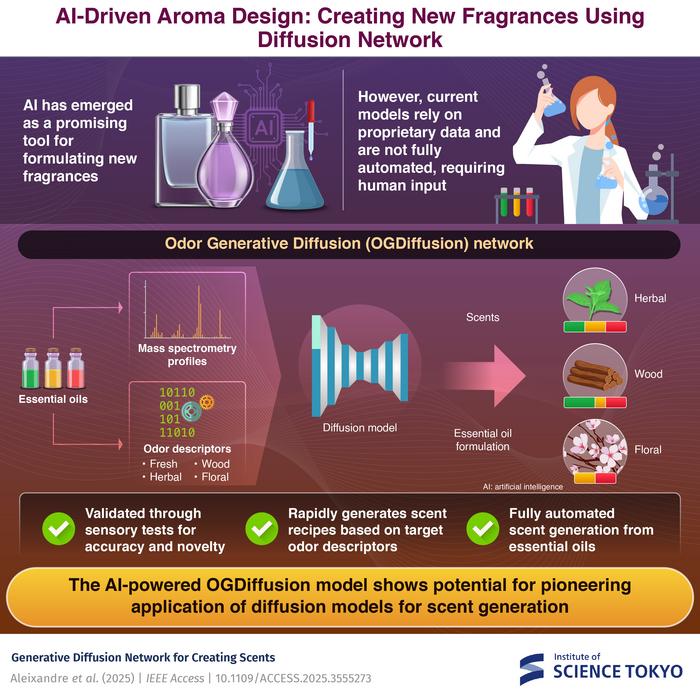
Addressing the challenges inherent in fragrance design has propelled researchers at the Institute of Science Tokyo into the spotlight with their groundbreaking innovation: an AI model capable of automating the creation of new fragrances tailored to user-defined scent descriptors. Utilizing advanced algorithmic techniques, this model integrates mass spectrometry profiles of essential oils along with their corresponding odor descriptors, enabling it to generate unique essential oil blends that encapsulate fresh scents. This pioneering effort marks a paradigm shift in the fragrance industry, steering clear of the traditional trial-and-error methodologies that have long characterized scent creation.
In industries where olfactory experiences play a critical role—perfume, food production, and home products—the demand for novel fragrances is paramount. Nevertheless, creating these scents through conventional means can be an arduous task, often relying heavily on the expertise and skill of specialized perfumers. The process is not only labor-intensive but also prone to inefficiencies and inconsistencies, making it tricky to replicate desired fragrances successfully. Hence, automating fragrance design offers immense potential for streamlining production and enhancing creativity.
The research team, spearheaded by Professor Takamichi Nakamoto, has introduced an AI model known as the Odor Generative Diffusion (OGDiffusion). Incorporating generative diffusion networks, this model represents a sophisticated type of machine learning model that adeptly learns to generate new content by reversing a noise process built upon existing data patterns. Although generative diffusion models currently find extensive applications in creating images and text, this team has breathed new life into this technology by adapting it for fragrance generation—a novel application that could revolutionize the industry.
Central to the operation of OGDiffusion is its analytical prowess, as it examines the chemical profiles or mass spectrometry data of 166 essential oils, each annotated with nine distinct odor descriptors ranging from “citrus” to “woody.” When the user specifies particular scent characteristics they desire, the AI generates a corresponding chemical profile or mass spectrum that aligns with those descriptors. This sophisticated algorithm then determines the necessary aerodynamic mix of essential oils required to recreate the specified scent, employing advanced mathematical methods like non-negative least squares, which ensures the output is grounded in sound data analysis.
Professor Nakamoto emphasizes the potential of their diffusion network, which utilizes expansive mass spectrometry data patterns to produce entirely new fragrance profiles through an approach that eliminates human intervention. By streamlining the process and maintaining high data quality, this AI framework offers a speedier, more accurate, and scalable fragrance generation system. Users, including novices, are empowered to curate scents easily, transforming the way scented digital content is produced.
The innovation in this domain is not without its competition; previous AI-based fragrance generation models have emerged, albeit with limitations. Many of these existing models rely on proprietary datasets and still necessitate the input of expert perfumers. The brilliance of the OGDiffusion model lies in its ability to fully automate the fragrance creation process, removing the barriers present in prior methodologies. Furthermore, as this system concocts fragrances based on essential oil recipes, the resultant scents can be seamlessly recreated, offering unparalleled consistency.
Beyond the technical capabilities of the OGDiffusion model, the team conducted extensive human sensory testing to validate the effectiveness of their automatic fragrance creations. In a meticulously designed double-blind study, 14 participants were tasked with matching AI-generated fragrances to appropriate descriptors—such as “citrusy” or “floral.” The results were overwhelmingly positive, as participants consistently identified the correct fragrances, confirming that the AI-generated scents aligned with their expectations. In a further exploratory test, participants successfully distinguished between two scents crafted with specific odor descriptors, reinforcing the notion that this model generates clear and identifiable scent profiles.
The implications of Nakamoto’s OGDiffusion model extend far beyond mere novelty. It is anticipated to herald a new era in fragrance design, one where artificial intelligence has a perceptible hand in creativity. Professor Nakamoto articulates this assertion clearly: “This approach represents a significant advancement in aroma design.” His groundbreaking work opens avenues for greater efficiency in creating fragrances, as well as potential applications across multiple industries eager to enhance their products through evocative scent design. A novice could soon wield the ability to craft meticulously defined aromas without needing extensive training or expertise.
In summary, the OGDiffusion model revolutionizes traditional fragrance crafting, marrying the empirical rigor of chemistry with the innovative potential of artificial intelligence. The ability to generate fragrances efficiently adds a layer of flexibility and creativity previously unseen in the industry. Its applications, ripe for exploration, encompass vast domains from perfumery to food technology—all while demonstrating the extraordinary possibilities that arise when science meets creativity. As we venture into a future increasingly defined by artificial intelligence, the OGDiffusion model stands as a testament to how algorithms can possess a sense of creativity, fundamentally altering the landscape of scent generation.
Subject of Research: AI-Driven Fragrance Design
Article Title: Generative Diffusion Network for Creating Scents
News Publication Date: 27-Mar-2025
Web References: IEEE Access
References: DOI 10.1109/ACCESS.2025.3555273
Image Credits: Institute of Science Tokyo
Keywords
Tags: advancements in aroma technologyAI and essential oil blendingautomated scent creation technologychallenges in scent creationcreative automation in olfactory experiencesefficiency in perfume productionfragrance innovation in industryfuture of fragrance designGenerative AI in fragrance designmass spectrometry in fragrance developmentOdor Generative Diffusion modeltraditional perfumery vs AI





